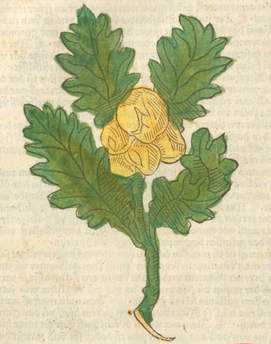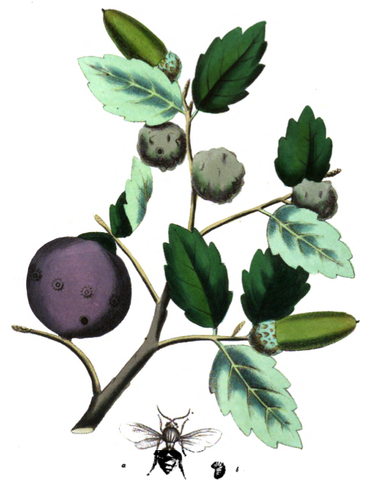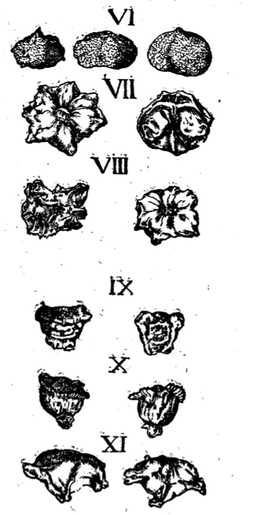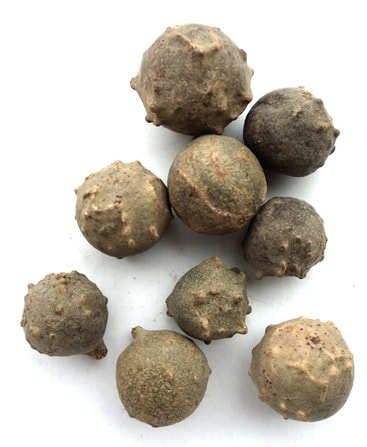Sentry Page Protection
Oak Gall
Medical Botany, Bohn, 1832
Medical Botany, Bohn, 1832
Some of the Gall varieties from Tabernaemontanus (1664)
Oak Galls (Adam, 2016)
Botanical name:
A number of Galls have been used:
Parts used:
Gall nuts from the insects which have infected the above-named trees
"Its best variety is unripe heavy and hard" (Avicenna)
Temperature & Taste:
Cold, very dry. Salty, Sour, slightly Sweet aftertaste.
Li Shi Zhen said it is Warm.
Classifications:
2N. REPELLENTS. 2O. ASTRINGENT. 2Z. CICATRIZING
4i. UTERINE
A number of Galls have been used:
- Oak Gall, ‘True’, European or Turkish Galls: infection of Adleria (syn. Cynips) gallae-tinctoriae on Quercus infectoria
- Chinese or Japanese Galls: infection of Melaphis chinensis or Schlectendalia chinensis on Rhus chinensis, R. potaninii and R. punjabensis
- English Galls: formed by Adleria kollari on Quercus robur
- Hungarian Galls: produced by Cynips lignicola on Quercus robur
- Pistacia Galls: Galls obtained from Pistacia integerrima (syn. P. chinensis, Rhus integerrima) or Rhus succedanea. These are used in Ayurveda and Unani medicine, but Chinese galls are also recognised.
Parts used:
Gall nuts from the insects which have infected the above-named trees
"Its best variety is unripe heavy and hard" (Avicenna)
Temperature & Taste:
Cold, very dry. Salty, Sour, slightly Sweet aftertaste.
Li Shi Zhen said it is Warm.
Classifications:
2N. REPELLENTS. 2O. ASTRINGENT. 2Z. CICATRIZING
4i. UTERINE
Uses:
1. Astringes to Stop Leakage (West, TCM, Ayurveda):
-chronic Diarrhea and Dysentery, including that with Blood
-Leukorrhea, Gonorrhea.
-prolapse of the Rectum or Uterus; woman would sit over a hot decoction to lift a prolapsed Uterus.
-Diabetes
-Spontaneous Sweating, Night sweats.
-"good for treating dysentery with bloody and whitish discharge and watery stool" (TCM: Tang Ben Cao)
2. Stops Bleeding (West, TCM, Ayurveda):
-chronic bleeding from the bowels with blood in the stool, bleeding Piles,
-all types of Bleeding in general. Can be used topically to stop bleeding.
-burnt or prepared Galls were preferred as a Hemostatic. (West)
3. Clears Phlegm, Stops Coughs, Consolidates the Lungs (West, TCM, Ayurveda):
-chronic Cough from Lung deficiency, evening cough due to Lung congestion;
-‘it expels and dries up Rheum and other fluxes, especially those that fall upon the Gums, almonds of the Throat, and other places of the Mouth’ (Culpeper).
-resolves Phlegm Nodes and Swellings
4. Clears Heat and Damp, Resists Poison:
-topically for Sores, damp Sores and Ulcers, Ringworm, and various toxic swellings.
-topically for local infections, both bacterial, viral and fungal.
-ancient physicians said it cleansed the skin if taken with Honey. (Celsus etc.)
5. Resists Poison:
-‘A general antidote to Poisons’; traditionally used for various poisons;
-in India they have been used as antidotes to the venom of Snakes and Scorpions
6. Astringes Essence:
-"It reinforces the blood and helps produce Jing, harmonizes qi and pacifies the mind". (TCM: Li Xun)
7. Externally:
-applied topically as a wash or powder to Sores, Toxic Swellings, Stubborn Ulcers, Fistulas, Ringworm, Skin Infections and ulcerous Dermatitis etc., where there is excess moisture.
-Fistula, burn the drug to ashes and apply (TCM)
-with Honey to whitlows, hang-nails, malformed nails, running ulcers, condylomatous swellings (Pliny)
-applied with Vinegar to Ringowrm (Avicenna)
-the powder is applied to damp-type Eczema.
-a paste is applied to Psoriasis.
-a wash to Sores in the Mouth and Nose, or a gargle for a Sore Throat.
-a decoction used as a mouth wash stops Bleeding of the Mouth.
-"Local application proves to be an effective treatment for corroded Teeth". (Avicenna)
-boiled in Vinegar, it makes a good wash for Itches.
-Burns. (TCM, West)
-traditionally to dye the whiskers and hair black (decocted in vinegar and used as a wash; since Dioscorides, TCM)
-topically, it is applied to Scar Tissue. (TCM)
-applied to Liver spots (decoction)
-in douches for Leukorrhea.
-in enemas for chronic Diarrhea, Prolapses
-topically to Hemorrhoids
Dose:
Taken with Vinegar to Reduce the Spleen
Powder: 500mg–2 grams
Preparation:
1. Steamed Galls
The fresh Galls are steamed to kill the insect inside or they can rot. Stir-frying will do the same.
Steamed Galls have beeb proven to be more effective as an anti-cancer medicine. (see here)
2. Scorched Galls
"The Galls are burnt on live coal" (Avicenna)
Burning helps reduce their cold nature, and enhances their astringent property.
3. Vinegar-prepared Galls
"The nuts [Galls] are burnt on live coals, soaked in vinegar and pounded to form a hemostatic application for all kinds of haemorrhage". (Avicenna)
Used as a Hemostatic, since Pliny and Dioscorides)
4. Fermented Galls
Galls have been fermented for use which renders them lighter and milder. A Chinese method of fermentation: 600 grams of Galls are coarsely powdered and boiled to a syrupy extract with 1 oz. of Tea leaves. Four ounces of yeast is then added and mixed well. It is covered and left to rise as in making bread. It is then rolled into cakes or pills and dried.
Correctives:
Tragacanth, Gum Arabic
Substitutes:
1. Aleppo Galls were always regarded as best; English and Chinese Galls are used synonymously with the English being weaker.
2. Pomegranate bark or pericarp, Acorns and Chebulic Myrobalans are all accepted substitutes (Unani)
Taken with Vinegar to Reduce the Spleen
Powder: 500mg–2 grams
Preparation:
1. Steamed Galls
The fresh Galls are steamed to kill the insect inside or they can rot. Stir-frying will do the same.
Steamed Galls have beeb proven to be more effective as an anti-cancer medicine. (see here)
2. Scorched Galls
"The Galls are burnt on live coal" (Avicenna)
Burning helps reduce their cold nature, and enhances their astringent property.
3. Vinegar-prepared Galls
"The nuts [Galls] are burnt on live coals, soaked in vinegar and pounded to form a hemostatic application for all kinds of haemorrhage". (Avicenna)
Used as a Hemostatic, since Pliny and Dioscorides)
4. Fermented Galls
Galls have been fermented for use which renders them lighter and milder. A Chinese method of fermentation: 600 grams of Galls are coarsely powdered and boiled to a syrupy extract with 1 oz. of Tea leaves. Four ounces of yeast is then added and mixed well. It is covered and left to rise as in making bread. It is then rolled into cakes or pills and dried.
Correctives:
Tragacanth, Gum Arabic
Substitutes:
1. Aleppo Galls were always regarded as best; English and Chinese Galls are used synonymously with the English being weaker.
2. Pomegranate bark or pericarp, Acorns and Chebulic Myrobalans are all accepted substitutes (Unani)
Main Combinations:
1. Chronic Diarrhea:
i. Galls with Chebulic Myrobalan
ii. Chronic Cold-type Diarrhea, Galls with Nutmeg
iii. Heat-type, Galls with Rhubarb
iv. Galls with Pomegranate, Comfrey, Red Earth, Rose, Cinnamon, Mastic (as in Pills Against Fluxes of Nicolas)
v. Galls with Pomegranate flower, Sumac, Indian Spikenard, Aloeswood, Coriander, Raisin (as in Powder for Chronic Diarrhea of Nicholas)
vi. Galls with Sorrel juice, Rose, Myrtle berry, Sandalwood, Tabasheer, Aloeswood, Clove, Nutmeg (as in Troches of Ramich of Mesue)
2. Bleeding:
i. blood in the Stool, combine Galls with torrefied Rhubarb root.
ii. bleeding from the Stomach, Galls with Chebulic Myrobalan, Alum
3. Diabetes, Nocturnal Emission, Galls with Poria Fu Ling, Dragon Bones (Long Gu) (as in Yu Suo Dan from Tai Ping Hui Min He Ji Ju Fang [Formulas of the Peaceful Benevolent Dispensary]). This formula was found 87% effective in the treatment of Diabetes according to Chinese sources.
4. Loose Teeth, make a decoction with Galls, Acorns, Alum and Rose to be held in the mouth
5. Toothache, a decoction of Galls in vinegar is held in the mouth; or the inner part of the Gall is chewed.
6. Hemorrhoids:
i. prepare an ointment of Galls with oil and wax or petroleum jelly.
ii. Galls powdered (2 drams), Camphor dissolved in a little alcohol (half dram), Lard (1 oz.). Mix.
7. Rectal prolapse, prepare a decoction of Galls and Chebulic Myrobalan, strain, add Alum, and use as a wash.
8. Scars, apply Galls and Centipede made into a paste with vinegar (TCM)
9. Gargle for Sore Throat, Galls with Pomegranate peel, Rose, Licorice (as in Gargle for Swollen Tonsils)
10. Mouth Ulcers or Gums Boils, apply powder of Myrrh, Galls and Frankincense bark (or Gum) mixed with Honey (Avicenna)
11. Pyogenic infections, apply Galls topically with Rhubarb (Da Huang)
12. Furuncles, mix Galls with Sesame oil and applied
Major Formulas:
Decoction for Sore Throat
Powder for Chronic Diarrhea (Nicholas)
Powder for Scrofula (Pharmacopoea Argentorarensis)
Powder for Scrofula (Arnold de Villa Nova)
Powder for Scrofula (Bononiense)
Powder for Phlegmatic Abscess of the Throat
Troches of Ramich (Mesue)
Electuary for Sadness and Worry
Electuarium Acharistum (Nicholas)
Pills Against Fluxes (Nicholas)
Balacaturbhadrika (Ayurveda)
Cautions:
1. Not used for acute Cough or acute Sore Throat
2. Not used in Constipation
Toxicity
Acute toxicity tests showed LD50 in rats for Chinese Galls was over 5000mg/kg
Subchronic administration of 1500mg/kg had no adverse effect.
Main Preparations used:
Infusion, Decoction, Tincture, Extract, Ointment, Astringent Injection, Astringent gargle
1. Infusion of Galls:
i. Bruised Galls (2 oz.), Boiling Water (1 pound). Macerate 24 hours, strain and filter. Dose: 2 spoonfuls every 2 hours for Diarrhea.
ii. Some used 1:8 (Galls to Water)
2. Decoction of Galls:
i. Galls (half oz.), Spring Water (2 lbs.). Boil to 1 pound. Dose: 1 spoonful. Also applied in lotions, prolapsed rectum, Liver spots.
3. Tincture of Galls:
i. Gall in powder (1 part), Proof Spirit (8 parts). Macerate 7 days, filter. Dose: 1–3 drams (Edinborough)
ii. Gall (half oz.), Alcohol (2 oz.). (Niemann)
4. Extract of Galls:
i. Galls, coarsely powdered, any quantity; exhaust them with several decoctions, add the decoctions together and evaporate the liquid in a water-bath.
5. Ointment of Galls:
i. Gall powder (1 part), Lard (8 parts). Mix. (Edinborough)
6. Astringent Injection (Enema, Douche):
i. Powdered Gall (2 drams), Boiling Water (1 pound). Infuse 1 hour, strain. (Pharmacopoeia extemporanea, Augustin, 1822)
ii. Gall (half oz.), Water (sufficient to obtain 8 oz. of decoction); strain and dissolve in Alum (2 drams), Zinc sulphate (2 grains). Mix. Used for obstinate mucus discharge from the urethra or vagina (blenorrhea). (Pharmacopoeia extemporanea, Augustin, 1822)
7. Astringent Gargle:
i. Decoction of Barley (4 oz.), Rose, Gall, Pomegranate bark (1 dram each), Red Wine (4 oz.), Honey of Roses (2 oz.), Sulphuric acid (sufficient to make acidic) (Ratier)
1. Not used for acute Cough or acute Sore Throat
2. Not used in Constipation
Toxicity
Acute toxicity tests showed LD50 in rats for Chinese Galls was over 5000mg/kg
Subchronic administration of 1500mg/kg had no adverse effect.
Main Preparations used:
Infusion, Decoction, Tincture, Extract, Ointment, Astringent Injection, Astringent gargle
1. Infusion of Galls:
i. Bruised Galls (2 oz.), Boiling Water (1 pound). Macerate 24 hours, strain and filter. Dose: 2 spoonfuls every 2 hours for Diarrhea.
ii. Some used 1:8 (Galls to Water)
2. Decoction of Galls:
i. Galls (half oz.), Spring Water (2 lbs.). Boil to 1 pound. Dose: 1 spoonful. Also applied in lotions, prolapsed rectum, Liver spots.
3. Tincture of Galls:
i. Gall in powder (1 part), Proof Spirit (8 parts). Macerate 7 days, filter. Dose: 1–3 drams (Edinborough)
ii. Gall (half oz.), Alcohol (2 oz.). (Niemann)
4. Extract of Galls:
i. Galls, coarsely powdered, any quantity; exhaust them with several decoctions, add the decoctions together and evaporate the liquid in a water-bath.
5. Ointment of Galls:
i. Gall powder (1 part), Lard (8 parts). Mix. (Edinborough)
6. Astringent Injection (Enema, Douche):
i. Powdered Gall (2 drams), Boiling Water (1 pound). Infuse 1 hour, strain. (Pharmacopoeia extemporanea, Augustin, 1822)
ii. Gall (half oz.), Water (sufficient to obtain 8 oz. of decoction); strain and dissolve in Alum (2 drams), Zinc sulphate (2 grains). Mix. Used for obstinate mucus discharge from the urethra or vagina (blenorrhea). (Pharmacopoeia extemporanea, Augustin, 1822)
7. Astringent Gargle:
i. Decoction of Barley (4 oz.), Rose, Gall, Pomegranate bark (1 dram each), Red Wine (4 oz.), Honey of Roses (2 oz.), Sulphuric acid (sufficient to make acidic) (Ratier)
Click the Tabs above for more information on this Medicine
Pliny on Galls:
|
'And no fewer are the varieties of the gall-nut which we have described; we have, for instance, the full-bodied gall-nut, the perforated one, the white, the black, the large, the small, all of them possessed of similar properties; that, however, of Commagene is generally preferred. These substances remove fleshy excrescences on the body, and are serviceable for affections of the gums and uvula, and for ulcerations of the mouth. Burnt, and then quenched in wine, they are applied topically in cases of coeliac affections and dysentery, and with honey, to whitlows, hang-nails, malformed nails, running ulcers, condylomatous swellings, and ulcerations of the nature known
|
as phagedaenic. A decoction of them in wine is used as an injection for the ears, and as a liniment for the eyes, and in combination with vinegar they are employed for eruptions and tumours. The inner part of the gall, chewed, allays tooth-ache, and is good for excoriations between the thighs, and for burns. Taken unripe in vinegar, they reduce the volume of the spleen; and, burnt and then quenched in salt and vinegar, they are used as a fomentation for excessive menstruation and procidence of the uterus. All varieties of the gall-nut stain the hair black.' (The Natural History of Pliny, trans. by Bostock and Riley, Vol. 5, 1856)
|
Pharmacographia, Fluckiger & Hanbury, 1879
|
'In China these galls are probably known and used both medicinally and in dyeing since very long; they are mentioned in the herbal Pen tsaou, written in the middle of the 16th century. They also occur in Cleyer's "Specimen medicine sinicae," Frankfort, 1682, No. 225, under the name u poi cu. Kampfer also mentions a tree "Baibokf, vulgo Fusi," growing on the hills, the
|
pinnate leaves of which he found often provided with an be imported into Europe about 1724, and are noticed by Geoffroy ' as Oreilles des Indes, but they seem to have soon disappeared from the market. Pereira directed attention to them in 1844, since which time they have formed a regular and abundant article of import both from China and Japan.'
|







